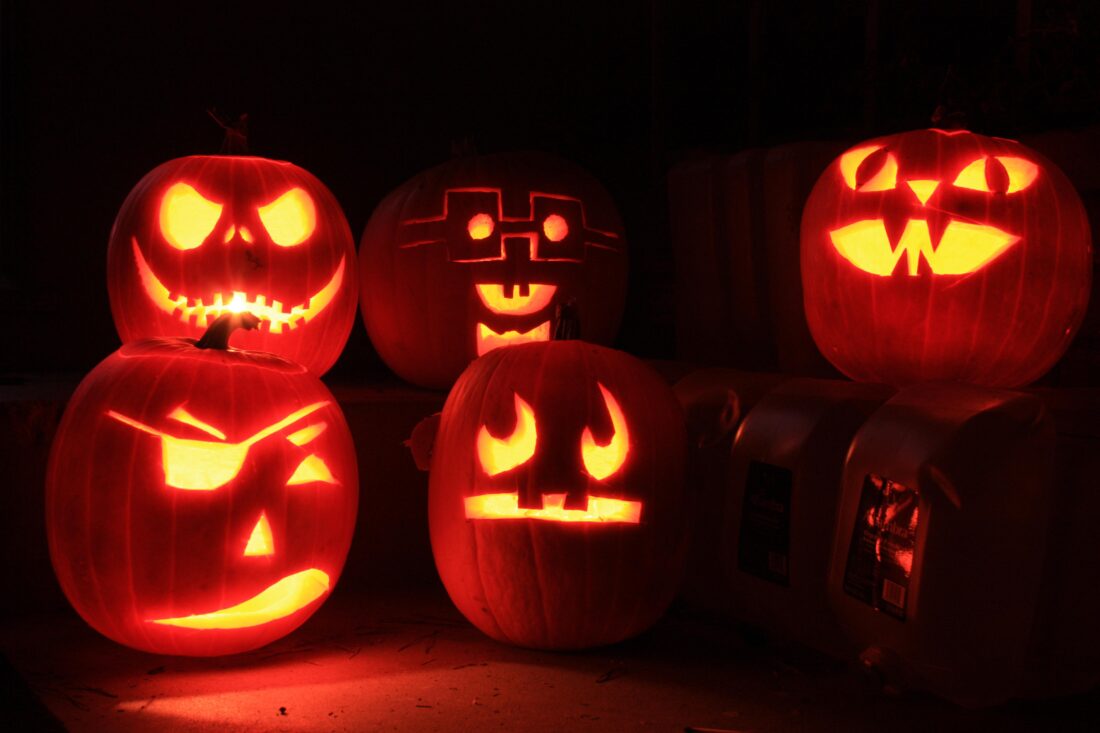Post-Halloween pumpkins serve a purpose

Photo by Jesse Palmer Jack-o-lanterns on a doorstep.
- Photo by Jesse Palmer Jack-o-lanterns on a doorstep.
- Pictured is a bird enjoying some pumpkin seeds.
If you’re like me and enjoy carving a jack-o-lantern to welcome the new season, you may want to repurpose the handfuls of seeds you pull out of a pumpkin’s core. Many decide to simply toss out the ooey-gooey parts of the pumpkin and immediately wash our hands of any unpleasant residue, but I encourage you to keep the slime and seeds for other uses. You might decide to keep these precious seeds to properly dry and roast them for a delicious homemade snack. Another alternative is to set these pumpkin seeds out on a stump outside and watch as local wildlife scamper over to have their own feast. Pumpkin seeds are high in fat and are calorie-dense, which are integral for animals to consume as temperatures inch closer to the coldness of winter. Chipmunks, birds, raccoons, and squirrels are just a handful of animals that are preparing their bodies for shorter days, less food, or even the long journey of migration. By giving a helping hand with something we may typically discard, pumpkin seeds will replenish an animal’s appetite.
Growing a pumpkin on your own for carving, baking, or decoration, begins in late springtime. My rule of thumb is to begin planting pumpkin seeds after the last frost or Mother’s Day weekend, which falls at the end of May. This ensures that it is warm enough for seeds to sprout and will be ready for a fall harvest. When planting, it is hard to envision how much space your pumpkins will need, but it is important to consider that we’re not just talking about the fruit that comes from the flower.
Pumpkin plants also include large vines, and as I like to call them, ‘feelers,’ which are tiny vines that shoot out directly from the stem. This helps the pumpkin find space to grow. If a ‘feeler’ touches another plant, a wall, or a fence, it may stunt growth. It is important to not step on these ‘feelers’, as they are a very sensitive part of the plant. These vines spread along the ground until they find a comfortable space to start producing a pumpkin. I recommend anywhere between 4 to 6 feet for space between plants, and a greater distance between rows, amounting to 10 or more feet. This gives our large garden plant plenty of space to flourish and grow. As you frequently check on your pumpkin plant, you will notice changes that happen throughout the growing season. What first begins as a tiny sprout will begin to spread, turning little knobs into yellow flowers which will become the orange pumpkin we are all so familiar with. In late summer, pumpkins are ready to harvest when pumpkins separate from their stem easily.
Over time, many jack-o-lanterns are left forgotten on our doorsteps and we begin to see the decomposition process right in front of our eyes. Carved faces once recognizable begin to warp, wrinkles appear, and these once sturdy pumpkins begin to fall over and shrink. Instead of tossing out a rotting pumpkin, I suggest you keep a pumpkin for science. This experiment makes for a great family science project, or if you are a classroom teacher, children will enjoy watching as pumpkins begin to change and break down over time. In order to do this safely, you begin by finding a smaller pumpkin to carve. Next, leave a handful of seeds inside this carved pumpkin (this will be important later!). Set the pumpkin on top of some damp soil inside a clear jar that is sealed shut with tape. Over the weeks, families and students will notice changes in the shape of the pumpkin and how its organic materials decompose and eventually start to look like the soil underneath it. Through this process, you will watch as mold appears and acts as a decomposer, helping shrink and deconstruct the pumpkin. Since some seeds were left in the jar, these seeds will use nutrients and humidity made from the newly created soil to begin the pumpkin life cycle all over again, starting with a small sprout that comes from what was once an entire pumpkin. A rotting pumpkin is an excellent visual representation of the decomposition process and how all plant matter is recycled back into the earth. This experiment will have observers of all ages interested in what changes day to day, week to week.

Pictured is a bird enjoying some pumpkin seeds.
Whether you decide to roast your pumpkin seeds, share them with local wildlife, or repurpose them in a science experiment, there are benefits to each intentional action we take when reusing, reducing, and recycling all parts of a plant, even the slimy bits. Next year and many after, I hope you remember to keep your pumpkin seeds and ‘unwanted’ parts, for they all have a special place in the natural world, beneficial to our own curiosity and the nutrition of animals around us.
Audubon Community Nature Center builds and nurtures connections between people and nature. ACNC is located just east of Route 62 between Warren and Jamestown. The trails are open from dawn to dusk and birds of prey can be viewed anytime the trails are open. The Nature Center is open from 10 a.m. until 4:30 p.m. daily except Sunday when it opens at 1 p.m. More information can be found online at auduboncnc.org or by calling (716) 569-2345.



